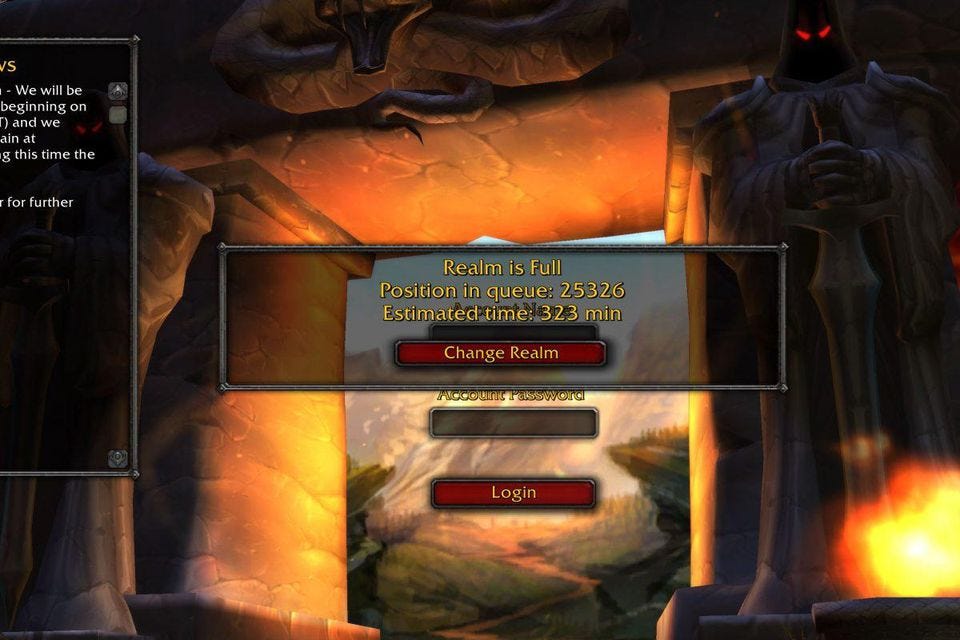People are waiting for five hours plus for a turn to play a game that is fifteen years old. They are staying up for 30 hours at a time to be among the first to complete certain objectives in that game. And some are streaming it, so you can watch the madness live.
Earlier this week, World of Warcraft Classic came out. After fifteen years of patches and expansions, Blizzard released a version of the game without all the balance and quality of life improvements they’ve made over the years. And people are loving it so much that all the servers are full and players are waking up at odd hours just to get in line.

High player counts leading to long wait times to enter the game
The WoW classic story is an interesting example of governance. For years, a loud minority fought for WoW classic support but the centralized operator of the game thought not supporting it was better for everybody. Then, members of that minority forked the game and launched a private server, earning a modest but significant playerbase of almost a million (that same year, there were roughly 6M WoW subscribers). Blizzard censored that fork. But then the playerbase was so loud they convinced Blizzard it was in their best interest too to launch WoW classic.
And given that WoW is by far the top game on Twitch right now and top streamers from different games (like shroud and timthetatman) have dropped everything to grind WoW, it seems like it was a good decision.
A rough timeline here (from this video):
2004: WoW released
2007: requests for WoW classic (one day after The Burning Crusade expansion was released)
2009-2012: increased requests for WoW classic; consistent stance from Blizzard that they have no plans to open classic realms
2013-2015: more demand for classic WoW. Game itself plateauing and players had nostalgia for the good old days
2015: Nostalrius private WoW server was launched and attracted 800,000 accounts. Interesting overview of private servers in this blog post.
2016: Nostalrius shut down by Blizzard. But after much community outrage, they started to seriously explore WoW classic and met with the Nostalrius team to discuss classic servers
2017: At BlizzCon, the annual Blizzard conference, Blizzard announces WoW Classic.
2019: WoW classic released to more demand than anybody imagined
Here’s what’s interesting to me:
If Nostalrius wasn’t censored, would it have grown to overtake retail WoW? My guess is no. It would continue being a small, niche community. They were at a natural disadvantage—no business model, “stolen” IP, and far fewer resources to build and moderate the world.
But if they could freely fork the game without the disadvantages mentioned above, could they have won? Maybe. Timing matters. As you can see in the chart of WoW subscribers over time, WoW Classic is reinvigorating a steadily atrophying game. Players have grown desensitized to new content. Now nostalgia is exciting.
Just like in blockchains, an unfortunate consequence about forks is fracturing the network effects. WoW Classic is taking players away from WoW retail. And for a game that gets more fun the more people are in and care about the world, that’s bad for WoW retail. But gaining on Classic at the loss of retail is okay for Blizzard. Losing on retail to an unofficial private server like Nostalrius is not okay for Blizzard.
I’ll be curious to see how Blizzard manages this splintering of the realm. If most players care about Classic, will they continue to invest in developing retail? As players move through Classic, will they start to add expansion servers chronologically? How will players move from one to another?
There’s something wonderful about being able to choose which state of the world you want to exist in. But having to maintain multiple states seems like a big headache for Blizzard and a potentially fracturing experience for players unless there’s one state that almost everybody prefers (e.g. Vanilla or Wrath of the Lich King).


